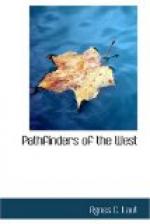When spring came, the Indians opposed his passage down the river. A council was called. Albanel explained that his message was to bring the Indians down to Quebec and keep them from going to the English for trade. The Indians, who had acted as middlemen between Quebec traders and the Northern tribes, saw the advantage of undermining the English trade. Gifts were presented by the Frenchmen, and the friendship of the Indians was secured. On June 1, 1672, sixteen savages embarked with the three Frenchmen. For the next ten days, the difficulties were almost insurmountable. The river tore through a deep gorge of sheer precipices which the voyageurs could pass only by clinging to the rock walls with hands and feet. One portage was twelve miles long over a muskeg of quaking moss that floated on water. At every step the travellers plunged through to their waists. Over this the long canoes and baggage had to be carried. On the 10th of June they reached the height of land that divides the waters of Hudson Bay from the St. Lawrence. The watershed was a small plateau with two lakes, one of which emptied north, the other, south. As they approached Lake Mistassini, the Lake Indians again opposed their free passage down the rivers.
“You must wait,” they said, “till we notify the elders of your coming.” Shortly afterwards, the French met a score of canoes with the Indians all painted for war. The idea of turning back never occurred to the priest. By way of demonstrating his joy at meeting the warriors, he had ten volleys of musketry fired off, which converted the war into a council of peace. At the assemblage, Albanel distributed gifts to the savages.
“Stop trading with the English at the sea,” he cried; “they do not pray to God; come to Lake St. John with your furs; there you will always find a robe noire to instruct you and baptize you.”
The treaty was celebrated by a festival and a dance. In the morning, after solemn religious services, the French embarked. On the 18th of June they came to Lake Mistassini, an enormous body of water similar to the Great Lakes.[13] From Mistassini, the course was down-stream and easier. High water enabled them to run many of the rapids; and on the 28th of June, after a voyage of eight hundred leagues, four hundred rapids, and two hundred waterfalls, they came to the deserted houses of the English. The very next day they found the Indians and held religious services, making solemn treaty, presenting presents, and hoisting the French flag. For the first three weeks of July they coasted along the shores of James Bay, taking possession of the country in the name of the French king. Then they cruised back to King Charles Fort on Rupert’s River.[14] They were just in time to meet the returned Englishmen.




